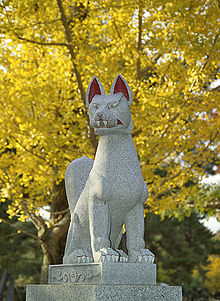Kitsune
Kitsune ( Japanese 狐 ; is the Japanese name for both the red fox ( Vulpes vulpes ) and the ice fox ( Alopex lagopus ). The red fox forms two subspecies in Japan : Vulpes vulpes japonica ( 本土 狐 , Hondo kitsune , German main island fox ) lives on Honshū , the largest of the four main islands. On the northern island of Hokkaido , the subspecies comes Vulpes vulpes schrencki ( 北狐 , Kita kitsune , dt. North Fuchs ) ago. Both subspecies play a major role in Japanese mythology . As can be seen from many representations, the white foxes in particular are considered sacred animals of the deity Inari .
As confidants of the deity Inari, who is sometimes depicted as a fox, kitsune are considered a good luck charm, but they often have other sides in fairy tales and legends.
Origins
It is not clear whether the kitsune myths are an integral part of Japanese culture or whether they were brought in from outside. In Japan they have probably been known since the 5th century BC; Similar myths are also known in Korea , China and India , but some of them differ greatly in the attribution of properties. In Chinese mythology, for example, the nine-tailed fox is the symbol of the Queen Mother of the West ( Xiwangmu ), while the Korean Kumiho , unlike the Japanese kitsune, is only depicted as evil. According to other opinions, the fox myths could have spread from India to Japan. Nevertheless, the foxes in Japan are assessed much more positively than in Korea and China, only a few negative characteristics have been adopted. This could be because humans and foxes lived close together in early Japanese society. Hence, the kitsune myths also contain elements of the original Japanese culture. ( see also: Kuzunoha )
Properties and essence
Numerous legends depict kitsune as hengeyōkai , beings with the gift of taking on human form. In these legends, a kitsune often appears as a very beautiful young woman and marries a man, often out of real and deep love. But as soon as he notices that he is married to a vixen, she disappears, never to be seen again, and leaves him with their children. In general, kitsune have a variety of supernatural powers. They can bring fertility, but also great calamity. You can create fire with the snout or the tip of the tail. They can take virtually any shape, with that of a human woman being just the most popular. They can also create illusions, fly or take possession of people. It should be noted that the kitsune's power increases with age and the number of their tails (a maximum of nine).
As for the essence of the kitsune, there are different statements in the sources. The foxes in Inari's service are generally considered to be good, and it is wise to keep them happy with prayers and offerings. They are also capable of gratitude. In the fairy tale The Grateful Foxes , two fox parents sacrifice their child to help a man who needs a fox liver to recover. The story The punished betrayal of the Tanuki shows another side of the Kitsune, where a young fox takes revenge on a Tanuki who tricked his mother and had her killed by luring her outside a hunting community.
Individual evidence
- ↑ UA Casal: The Goblin, Fox and Badger and other Witch Animals of Japan , In: Asian Folklore Studies Jg. 18, 1959, ISSN 0385-2342 , pp. 1–94 (PDF; 4.9 MB) ( Memento of the original dated September 27, 2007 in the Internet Archive ) Info: The archive link was inserted automatically and has not yet been checked. Please check the original and archive link according to the instructions and then remove this notice. .
literature
- Bodo Petersdorf: Fairy Tale Treasure of the World - Fairy Tales from Japan , Weltbild, Augsburg 1994, ISBN 3-89350-611-X
- Ditte and Giovanni Bandini: Who's Who in Heaven , Deutscher Taschenbuch Verlag, Munich 2000, ISBN 3-423-32539-9
- Anne Birell: Chinese Myths , Phillip Reclam jun. GmbH & Co., Stuttgart 2002, ISBN 3-15-010496-3
- Richard Wilhelm: Chinese fairy tales , Eugen Diederichs Verlag, Munich 1958
- Klaus Mailahn: The fox in faith and myth , Münster 2006, pp. 169-213, ISBN 3-8258-9483-5
- Karen A. Smyers: The Fox and the Jewel . Shared and private meanings in contemporary Japanese Inari worship, Honolulu 1999, ISBN 0-8248-2102-5
- Johnson, TW: "Far Eastern Fox Lore1" , in: Asian Folklore Studies , Vol. 33/1 (1974), pp. 35-68.
Web links
- Bernhard Scheid: Füchse und Tanuki , in the web handbook Religion in Japan , September 20, 2010, University of Vienna

